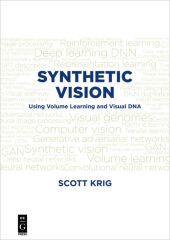 Neuerscheinungen 2018Stand: 2020-02-01 |
Schnellsuche
ISBN/Stichwort/Autor
|
Herderstraße 10
10625 Berlin
Tel.: 030 315 714 16
Fax 030 315 714 14
info@buchspektrum.de |

Synthetic Vision
Using Volume Learning and Visual DNA
2018. XVIII, 350 S. 40 col. ill., 15 b/w tbl., 5 col. graphics. 240 mm
Verlag/Jahr: DE GRUYTER; DE G PRESS 2018
ISBN: 1-501-51517-9 (1501515179)
Neue ISBN: 978-1-501-51517-0 (9781501515170)
Preis und Lieferzeit: Bitte klicken
In Synthetic Vision: Using Volume Learning and Visual DNA , a holistic model of the human visual system is developed into a working model in C++, informed by the latest neuroscience, DNN, and computer vision research. The author´s synthetic visual pathway model includes the eye, LGN, visual cortex, and the high level PFC learning centers. The corresponding visual genome model (VGM), begun in 2014, is introduced herein as the basis for a visual genome project analogous to the Human Genome Project funded by the US government. The VGM introduces volume learning principles and Visual DNA (VDNA) taking a multivariate approach beyond deep neural networks. Volume learning is modeled as programmable learning and reasoning agents, providing rich methods for structured agent classification networks. Volume learning incorporates a massive volume of multivariate features in various data space projections, collected into strands of Visual DNA, analogous to human DNA genes. VGM lays a foundation for a visual genome project to sequence VDNA as visual genomes in a public database, using collaborative research to move synthetic vision science forward and enable new applications. Bibliographical references are provided to key neuroscience, computer vision, and deep learning research, which form the basis for the biologically plausible VGM model and the synthetic visual pathway. The book also includes graphical illustrations and C++ API reference materials to enable VGM application programming. Open source code licenses are available for engineers and scientists.
Scott Krig founded Krig Research to provide some of the world´s first vision and imaging systems worldwide for military, industry, government, and academic use. Krig has worked for major corporations and startups in the areas of machine learning, computer vision, imaging, graphics, robotics and automation, computer security and cryptography. He has authored international patents in the areas of computer architecture, communications, computer security, digital imaging, and computer vision, and studied at Stanford. Scott Krig is the author of the English/Chinese Springer book Computer Vision Metrics, Survey, Taxonomy and Analysis of Computer Vision, Visual Neuroscience, and Deep Learning, Textbook Edition , as well as other books, articles, and papers.
Part One
Neuroscience
Deep Learning
Computer Vision
State-of-the-art Methods
Part Two
The NeuroMatrix Model of the Human Visual System
The Model in Detail
Part Three
Using the Neuro Matric Library for Synthetic Vision
Coding Solutions in C++
Appendixes
Bibliography
Resources Guide
Scott Krig founded Krig Research in 1988, providing some of the world´s first vision and imaging systems worldwide for military, industry, government, and academic use. Scott has worked for major corporations and startups in the areas of machine learning, computer vision, imaging, graphics, robotics and automation, computer security and cryptography. He has authored international patents in the areas of computer architecture, communications, computer security, digital imaging, and computer vision. Scott is the author of several books, articles and papers, and studied at Stanford.


